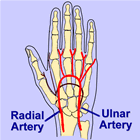|
Angioplasty and Stenting
from the Wrist: Society for Cardiovascular Angiography and Intervention
(SCAI) Issues Its First Report on Transradial Access
|
 |
 |
|
May 5,
2011 --
The Society for Cardiovascular Angiography and Intervention
(SCAI) released its first official report on transradial
(wrist) access for angioplasty and stenting at its annual
meeting, being held in Baltimore, MD this week. Published
simultaneously in Catheterization and Cardiovascular
Interventions, the 17-page report covers a wide range
of topics, such as patient selection and preparation, artery
access,
catheter
and therapy selection, primary PCI, potential complications
and training for interventional cardiologists performing
procedures via radial access.
|
| Ever since cardiac
catheterization was first utilized to diagnose coronary artery
disease in the
1960's, cardiologists and device companies have tried to make
the procedure easier to perform and safer for patients. The two
founders of SCAI were also inventors of the two most widely used
techniques at the time: the brachial approach, used by Dr. Mason
Sones and the femoral approach, perfected by Dr. Melvin Judkins (still
the major approach used worldwide). These pioneers combined forces
in 1978 to create an organization that championed and
facilitated
quality
and safety
in cardiac
imaging. So it is only fitting that the first overview of this
alternate technique from a professional medical society in the
U.S. was made by SCAI. |
|

Mason Sones
and Melvin Judkins: Founders of SCAI |
As has been written in these pages for some time
now, the transradial approach, where angioplasty and stenting is
done from the radial
artery in the wrist, is not exactly new. It has been practiced in
Canada, Europe and Asia for well over a decade and currently accounts
for half of the catheter-based procedures performed in Europe. But
in the United States, the transradial technique is relatively new:
only about 5% of procedures are done this way.
But the technique is rapidly catching
on because of its benefits regarding patient comfort, rapid ambulation
and lower
bleeding
complications. One of the challenges therefore is training -- making
sure that cardiologists learn the correct way to perform transradial
procedures.

Dr. Ronald
Caputo |
|
These concerns were stated by Ronald
P. Caputo, M.D., FSCAI, the report's lead author and Director of Cardiac
Services,
St. Joseph's
Hospital
in Syracuse, NY. He stated:
"Data increasingly show that
the radial technique, which many patients find more
comfortable, is also safe and effective.... As this technique is used
more frequently in the United States, we want to ensure
it is used safely and appropriately."
|
Regarding training, the report recommends three levels of competency,
based on the individual interventional cardiologist's level of experience
with simple and complex cases, including patients with challenging
anatomy. The authors emphasize that interventional cardiology trainees
should develop equal competency in both femoral and radial approaches,
and guidelines should be developed to address best practices for
safe use of the radial technique.
"To ensure patients receive the best possible care, we recommend
developing training programs that provide interventional cardiologists
with opportunities to learn and test their skills in the radial technique," said
Jennifer A. Tremmel, M.D., M.S., FSCAI, report co-author and Director
of the Transradial Program at Stanford University Medical Center
in Stanford, CA.
And SCAI has been sponsoring training programs over the past six
months: in Boston, Philadelphia and coming up in Los Angeles. In
addition, various hospital centers and physicians with experience
in the radial technique are also sponsoring one or two day workshops.
A complete list can be found in Angioplasty.Org's Radial
Training Courses.
The authors of the report on Transradial Angioplasty
(TRA) conclude:
"TRA for percutaneous revascularization
has seen steady growth worldwide since the initial experience described
by Campeau in 1989. Benefits to TRA include a lower incidence of
access site and bleeding complications, higher patient satisfaction,
and potentially lower overall costs compared to transfemoral access.
TRA has been successfully utilized for a variety of indications
including primary PCI, bypass graft angiography and PCI, and noncoronary
revascularization. However, guidelines regarding training and competency
are lacking, and will need to be more clearly defined as the current
trend of increasing adoption continues in the United States."
About The Radial Access Center on Angioplasty.Org
To assist in educating the professional and patient population in the U.S. about
the this technique, Angioplasty.Org created the "Radial
Access Center for Transradial Approach" in 2007, a special
section devoted to information and news about the transradial technique, for
both patients and physicians. The Radial Center features interviews with leading
practitioners of the radial technique, such as Drs. Jeffrey Popma, Sunil Rao,
Mauricio Cohen, John Coppola, Shigeru Saito and Jennifer Tremmel.
For interventional cardiologists and cath lab staff,
Angioplasty.Org also maintains a
listing of upcoming training courses in the transradial
approach. For patients, there is a unique "Radial
Hospital Locator" that lists U.S. centers practicing
radial angiography. As Dr. Howard Cohen of Lenox Hill Hospital in
New York says of the wrist technique, "Patients really prefer
it. 95% of people who've had it both ways would say 'I'm coming back
to you, Dr. Cohen because I like this transradial a lot better than
the other way!'
Reported by Burt Cohen, May 5, 2011
|



